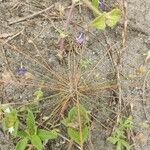Stems setaceous, glabrous and smooth, 5-30 cm by ¼-⅓ mm. Leaves much shorter than the stems, capillary, glabrous (except for the long white hairs at the orifice of the sheaths), smooth or slightly scaberulous at the top, ¼-⅓ mm wide. Inflorescence capitate, hemispherical, with (1-)3-20 spikelets, 5-15 mm across. Involucral bracts 1-3, somewhat shorter to much longer than the inflorescence, filiform, with dilated scarious base, 5-20 mm. Spikelets sessile, ovate to oblong, acute, 3-8 by 1-1½ mm. Glumes membranous, ovate, mucronulate (mucro finally excurved), strongly keeled, with nerve-less sides and minutely ciliolate margins, otherwise glabrous or but slightly puberulous, rusty brown with green keel, 1½-2¼ by 1¼-1½ mm. Stamen 1; anther oblong-linear, c. ½ mm. Style ¾-1 mm; stigmas 3, shorter than the style. Nut triquetrous, broadly obovate, smooth, finely reticulate by the minute isodiametric epidermal cells, whitish to stramineous, 0.5-0.75 by 0.4-0.6 mm.
Herbs, annual, densely cespitose, scapose, low. Culms 5–20(–30) cm. Leaves to 2/3 length of scapes; sheaths greenish or tan, glabrous or hispidulous on ribs; blades spreading, filiform, 0.5 mm wide, involute, margins scabridulous. Inflorescences: scapes filiform, coarsely few ribbed, to 0.5 mm thick; spikelets in terminal headlike, involucrate clusters, 1–1.5 cm wide; involucral bracts with setaceous blades rarely exceeding inflorescence. Spikelets red to red-brown or dull brown, lance-ovoid to lanceoloid or linear oblong; fertile scales lanceolate, keeled, 1.2–2.2 mm, glabrous, midrib excurrent as mucro. Flowers: stamens 1; anthers oblong, 1 mm. Achenes trigonous, obovoid, 0.5–0.6 mm, angles often sharp, faces flat or slightly concave, finely reticulate; tubercle a small button. 2n = 10.
A tufted annual sedge. It grows 2-35 cm high. The stems are 4-6 angled and grooved. The leaves are about half the length of the stem. The leaves roll inward and look like stems. There can be a few or many flowering stalks. They are in a head. The flowers are brown. The nuts are about 0.6 mm. They are triangle shaped.
Acute radiating spikelets in a hemispherical head
Tufted annual 5–20 cm. high

